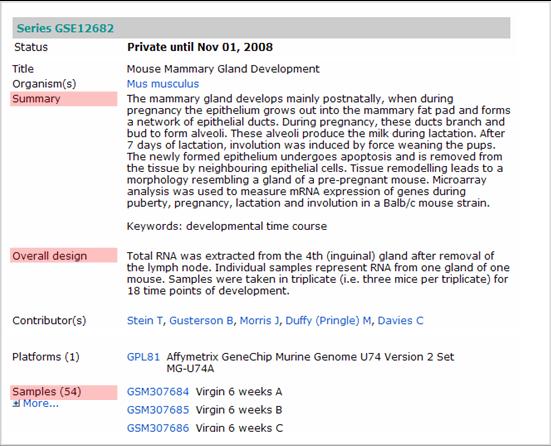Guidelines for reviewers and journal editors
Getting access to private data
Reviewers should expect to receive a reviewer token with the manuscript. This token allows anonymous, confidential access to the private GEO records cited in the paper. If a reviewer token was not supplied with the manuscript, the reviewer should contact the journal editor, not GEO, to request that a reviewer token is generated.
Once a GEO submission is complete and has been approved by curators, the authors are invited to generate the reviewer token - this is a very quick process, the author simply has to log in to their GEO account and click the 'Reviewer access' link located at the top of their Series record. Authors are instructed to include this token with their manuscript when they send it to the journal for review. The journal editors should ensure that reviewers receive the token. The reviewers then can enter the token on the Series record page to get access.
How to evaluate the data Back to top
The Minimum Information About a Microarray Experiment (MIAME) guidelines were developed by the MGED Consortium to outline the information necessary to describe a microarray experiment. Many journals and funding agencies require microarray data to comply with MIAME. It is recommended that reviewers use these guidelines to assess if an experiment has been sufficiently described.
GEO deposit procedures are designed to encourage MIAME-compliant submissions. Before approval, each submission is assessed by a GEO curator. If critical MIAME components are missing, the curator will attempt to work with the authors until the issue is addressed. However, without having access to manuscript details, it can be difficult for us to assess if sufficient descriptive information has in fact been supplied. Also, curators perform only basic checks for obvious errors in data (e.g., duplicated or truncated tables); we perform no actual data analysis, so we are not in a position to assess the validity or accuracy of the conclusions as discussed in the manuscript.
Reviewers should also be aware that not all GEO features and downloads are available for private records. For example, the batch SOFT and MINiML family dumps, SeriesMatrix files, and tar archives of supplementary files become available only after the records are made public.
If a reviewer determines that a submission does not meet MIAME requirements, or lacks information critical to experiment interpretation, the authors should be asked to update their GEO records accordingly.
MIAME has 6 main components:
- Sufficient annotation of the array
- Essential sample annotation including experimental factors and their values
- Essential laboratory and data processing protocols
- Final processed (normalized) data
- Raw data for each hybridization
- The experimental design including sample data relationships
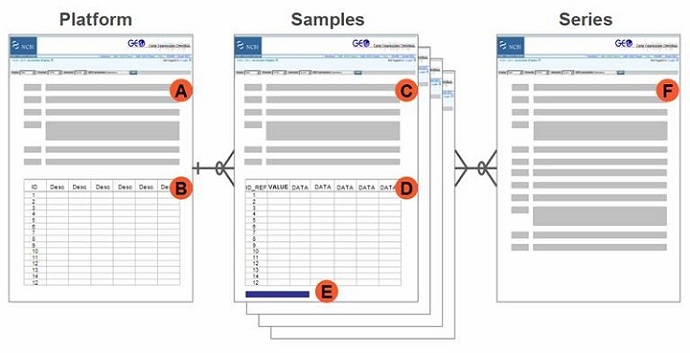
| A | Text description of the array |
|---|---|
| B | Array annotation table |
| C | Text description of a biological sample and protocols to which it was subjected |
| D | Processed hybridization result table (may optionally include raw data columns) |
| E | Raw data comment and link (if supplied) |
| F | Text description of the overall experiment |
Array annotation Back to top
The array template is defined in the Platform record table (area 'B' on the schematic).
Great variability exists in annotation conventions.
The table may include any number of columns but must always include at least one category of representative stable,
trackable, sequence identifier for each feature on the array. This may include the nucleotide sequence itself, a GenBank accession number,
a public clone identifier or genomic coordinates. Gene names alone are not ideal since these can change over time.
Each ID in the ID column is unique and references the ID_REF column of Sample record tables.
Note that when a commercial array has been used, the authors will not own the Platform record and will not have control over the annotation.
Sometimes the array will represent a 'condensed' template, e.g., one where replicate probes are combined. In these cases, a complete template
should also be supplied and it will be attached to the foot of the Platform record as a 'Supplementary file' link.
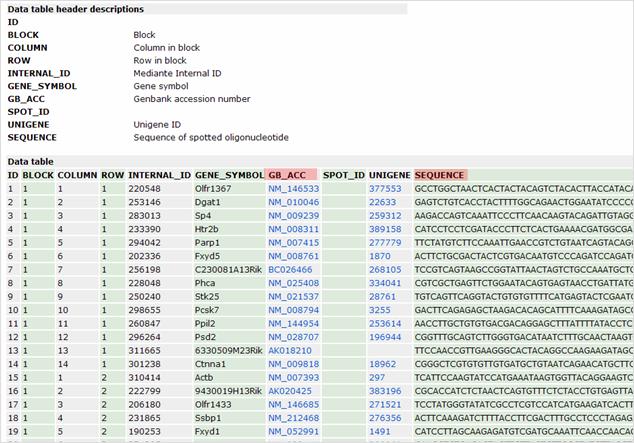
Sample annotation and Protocols Back to top
Submitters provide descriptive information and protocols for each of the Samples in their study by completing several Sample attribute fields (area 'C' on the schematic). The following depicts a typical record with Sample annotation highlighted in red and protocols highlighted in yellow. Most of these fields are free text and may contain large volumes of information to thoroughly describe the Sample characteristics and variables, and how they were processed.
TIP: To simultaneously view descriptive data for all the Samples in an experiment,
go to the Series record and set the tool bar at the head of the page to:
Scope: Samples
Format: HTML (or SOFT to download text format)
Amount: Brief
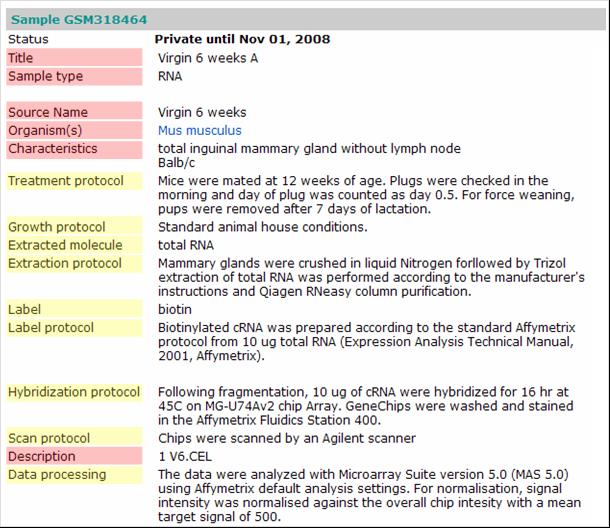
Processed data Back to top
A comment regarding the presence and location of processed data is provided at the foot of each Sample record
(area 'E' on the schematic).
As in the example below, processed data are usually provided within the table on the Sample record
(area 'D' on the schematic).
Sample tables may contain any number of columns, but all contain a VALUE column which represents
the final processed values as supplied by the submitter, and an ID_REF column that references the ID column in the corresponding Platform record.
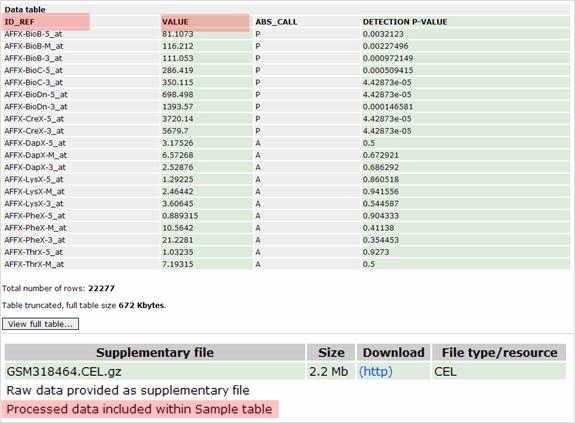
Raw data Back to top
A comment regarding the presence and location of raw data is provided at the foot of each Sample record (area 'E' on the schematic).
As in the example below, raw data are usually provided as a supplementary file in the native format (e.g., .CEL or .GPR).
Occasionally, raw data columns may be included within the table of the Sample record (area 'D' on the schematic).

Experiment design Back to top
The Series record includes information about the overall experiment and its design (area 'F' on the schematic).
Most of the Series fields are free text and may contain large volumes of information in which to thoroughly describe the experiment.
The Series also lists and links all the Samples it includes.
